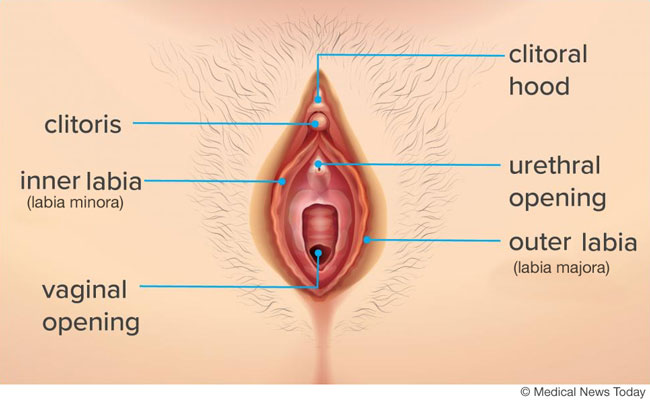
Clitoral hood reduction is a procedure that reduces the size and area of the clitoral hood to expose more of the clitoris itself. The goal of the surgery is to improve a woman's sexual functioning and satisfaction and to improve vulvar aesthetics in combination with labiaplasty.
Why women consider Clitoral Hood Reduction
- Decreased sexual satisfaction or gratification
- Decreased sensation with sexual intercourse
- Inability to achieve orgasm
About Excessive Clitoral Tissue
About the Clitoral Hood

Female Anatomy
The clitoral hood is the “flap of skin” around the top of the clitoris and it comes in all shapes and sizes. It is analogous to the male forskin. The purpose of the clitoral hood is to provide physical protection or cover for the clitoris. Remember, the role of the clitoris is to provide stimlulation during sexual activity. Consequently, it is full of thousands of nerve endings. Without the clitoral hood, irritating clitoral stimulation can occur. The clitoral hood is important – but it has to function appropriately.
With sexual arousal or stimulation, the clitoris becomes engorged and enlarges. This enlargement results in the clitoral hood retraction and purposeful exposure of the clitoris for stimulation. In addition to enlargement of the clitoris to cause exposure of the clitoris, the clitoris secretes a lubricant (called sebum) that allows the clitoral hood to glide over the clitoris. Both the lubrication of the clitoral hood and enlargement of the clitoris results in the clitoral hood gliding back to allow exposure of the clitoris during sexual activity.
About Excessive Clitoral Hood Tissue
An excessive or enlarged clitoral hood can potentially prevent exposure of the clitoris for stimulation during sexual arousal. Adhesions or scarring of the clitoral hood can also prevent clitoral hood gliding and exposure of the clitoris. Surgery to either reduce the clitoral hood tissue and to address scarring can improve exposure to the clitoris during sexual activity.
Peri-clitoral tissue also comes in all shapes and sizes. This tissue is often extensions of the labia minora. Patients with redundant or excessive labia minora tissue as a result often have excessive peri-clitoral tissue. Just as there is no normal labia, there is no normal peri-clitoral tissue. This area comes in all shapes and sizes. However, some women elect to reduce the peri-clitoral tissue for appearance.

